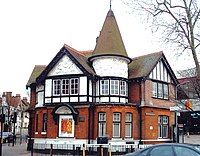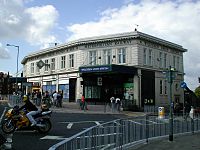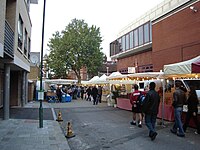Willesden
| Willesden | |
| Middlesex | |
|---|---|
| Location | |
| Grid reference: | TQ227846 |
| Location: | 51°32’48"N, 0°13’46"W |
| Data | |
| Post town: | London |
| Postcode: | NW10, NW2 |
| Dialling code: | 020 |
| Local Government | |
| Council: | Brent |
| Parliamentary constituency: |
Brent Central |
Willesden is a town in Middlesex deep within the metropolitan conurbation.
The name of the town is form the Old English Wielles dun, meaning Hill of the Spring, and a settlement bearing this name dates back to 939 AD. The Domesday Book of 1086 records it as Wellesdone. However, on 19th century maps of the town such as those from the 'Ordnance Survey First Series', the town is shown as Wilsdon.
History
From the 14th to 16th centuries, the town was a place of pilgrimage due to the presence of two ancient statues of the Virgin Mary at the Church of St Mary. One of these statues is thought to be a Black Madonna, which was particularly condemned by the Lollards. There was also a "holy well" which was thought to possess miraculous qualities, particularly for blindness and other eye disorders.
At the Reformation the Marian idols were taken to Thomas Cromwell's house and burnt in 1538 on a large bonfire of "notable images" including those of Walsingham, Worcester and Ipswich.
Modern history

The parish of Willesden remained predominantly rural up until 1875, when its population was 18,500. However, this changed with the opening of the Metropolitan Railway (later the Metropolitan Line) station of Willesden Green on 24 November 1879. By 1906 the population had grown to 140,000, a phenomenon of rapid growth that was to be repeated in the 1920s in neighbouring areas such as Harrow. The Metropolitan Line service was withdrawn in 1940, when the station was served by the Bakerloo Line, and later the Jubilee Line.
The First World War caused Willesden to change from a predominantly Middle Class suburb to a Working Class part of London. After the war, Willesden grew rapidly as numerous factories opened up with numerous flats and houses. The local council encouraged building to prevent large unemployment and decline.
To the present day, Willesden has been shaped by the patterns of migration which marks it out as one of the most diverse areas in the United Kingdom. The 1901 United Kingdom census recorded that 42% of the population was born in London. In 1923, the specialist coach builder Freestone and Webb established their base in Willesden, producing bespoke cars on Rolls-Royce and Betley chassis until 1956.
Willesden became a municipal borough in 1933, and it is at this time that the area became predominantly working-class. A small Irish community had formed in Willesden by this time, which grew rapidly during the period of the Second World War. A small Jewish Community of refugees from Europe also formed during the war, with 3.5% of the population in 1951 born in Germany, Poland, Russia or Austria. During the war, Willesden suffered large damage due to the heavy concentration of industry, such as munition factories, and railways in the area.

The period from 1960 saw migrants settling from the Caribbean and the Indian Subcontinent. Additionally, from 1963 it was the site of the Kuo Yuan, the first Chinese restaurant to serve Pekinese dishes in Britain.[1] Since the 1960s, Willesden has been popular with young working holidaymakers from Canada, Australia and New Zealand, although this popularity has declined somewhat in favour of other areas since about 2003.
Willesden went into a period of decline during the 1970s and 1980s as much of the housing was inadequate due to overcrowding as industry was mixed with housing. The whole of central Willesden bar (the area by the Willesden Green station) was earmarked for redevelopment; however, this did not come to fruition. In the late 1980s, traders were given money to revamp the High Street to prevent it closing.
Now the area has seen a change in demographic becoming a middle class area due to its prime location and good transport links.

In popular culture
- The town was featured notoriously in the popular novel White Teeth by Zadie Smith in 2000 which was subsequently made into a TV series. Moreover, Joe Strummer and the Mescaleros sang from 'Willesden to Cricklewood' on their album Rock Art and the X-ray Style.
- Willesden is also the origin of the formation of the 1980s breakdance group The Willesden Dodgers with Pete Q. Harris, Nigel Green and Richard Jon Smith as the main members.
- "Willesden Green" is also the title of a song written by Ray Davies and performed by The Kinks and is included in the soundtrack of the 1971 film "Percy". The Kinks Willesden Green Lyrics:
- Willesden Green is a running reference/joke on the animated TV cartoon series Danger Mouse.
- Jonathan Creek is regularly filmed around Willesden as was "The Last Detective" which used The Rising Sun pub as its central base.
- The Bonzo Dog Doo-Dah Band make a short reference to Willesden Green on their track "Shirt", the second track of their 1969 album Tadpoles. quote: "Now, here in Willesden Green, yes, brrr, it is a bit chilly but no matter. Here comes a gentleman and we're going to talk to him about shirts"
- Lead Balloon a BBC4 sitcom starring Jack Dee is filmed mainly in Willesden.
- In Willesden was a static inverter plant of HVDC Kingsnorth.
Cycling
Willesden is home to London's largest cycling club, with over 200 members.[2] Founded in 1926 Willesden Cycling Club (or WCC) is still going strong, with competitive riders in many disciplines, in the form of Track cycling, Time Trials, Road Racing and particularly AUDAX events. The club also provides grass-roots coaching and social rides as well as frequent "club runs" into the Chilterns and surrounding areas.
Outside links
References
- ↑ Jay Rayner. "The sweet and sour revolution". The Observer. 10 November 2002.
- ↑ as at January 2009